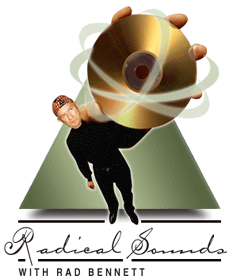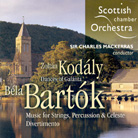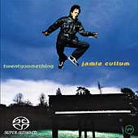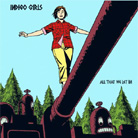 |
| October 1, 2004 Two Can Be as Good as 5.1 Regular readers will know that though I think the ability of the
new high-resolution formats to reproduce more channels -- and, in the case of DVD-Audio,
video supplements -- is really cool, it is the higher sonic resolution itself that
provides the formats’ raison d’ętre. From the beginning of this latest
sound revolution, I have desired to hear my favorite two-channel recordings in all their
glory -- the bit-challenged CD format simply does not capture every nuance of those analog
master tapes. Regular readers will know that though I think the ability of the
new high-resolution formats to reproduce more channels -- and, in the case of DVD-Audio,
video supplements -- is really cool, it is the higher sonic resolution itself that
provides the formats’ raison d’ętre. From the beginning of this latest
sound revolution, I have desired to hear my favorite two-channel recordings in all their
glory -- the bit-challenged CD format simply does not capture every nuance of those analog
master tapes.
Producers of SACD and DVD-A releases have focused on multichannel recordings, feeling that these will sell better to a public now oriented more toward video than audio. Some two-channel recordings have been released -- oddly enough, more of pop music than of classical. Many of the latter have been remixed into multichannel formats that sound good but are not strictly faithful to the original intents of the producers and recording engineers. Faced with those facts, Telarc has been courageous in issuing its late-1970s Soundstream recordings on two-channel SACDs. More than a year ago, the company released some of its best, including most of the recordings it made with Lorin Maazel and the Cleveland Orchestra. These included Stravinsky’s Le Sacre du Printemps, Tchaikovsky’s Symphony 4, and Shostakovich’s Symphony 5. Now the label has released three more sets of Soundstream masters on SACD. The Soundstream recording system, which Telarc employed for most of the recordings it made through the mid-1980s, used a sampling rate of 50kHz, compared to the standard CD rate of 44.1kHz. In downrezzing the music for CD, Telarc had to compromise the sound of the original masters. Now, with the advent of Direct Stream Digital (DSD) technology, it is possible to transfer those masters at their original resolution. All of the new Telarc SACD discs are hybrid, containing a CD layer that is also improved from the original CD release, due to new conversion technology. Is there a difference? You bet. Telarc has paired Saint-Saëns’s Symphony 3, the "Organ Symphony," with the complete Encores ŕ la française album, performed by Michael Murray on the organ in Boston’s Symphony Hall [Telarc SACD-60634]. The first track of that recital, Couperin’s Chaconne in G Minor, has always been a favorite demo piece; I’ve often used it to balance a subwoofer with the rest of my system. In the transcription Murray plays, by Joseph Bonnet, the sound of the full organ is contrasted with quieter interludes, and there is a lot of subwoofer bass. That bass was there on the CD, but on the SACD I can sense and hear the air quivering and resisting as each note begins. The highs are sweeter, with more air around them. This will remain one of my demo discs, but now even more so. The Saint-Saëns symphony, performed by Eugene Ormandy and the Philadelphia Orchestra with Murray at the organ, is no less impressive. Delicate sounds, such as the four-hand piano parts in the finale, emerge with greater clarity, and there is increased overall presence, without any harsh glare. One of the first releases from Telarc, and one of the first digitally mastered recordings, was that of the two Suites for Military Band by Gustav Holst, and Handel’s Royal Fireworks Music. Even in its early, pre-CD digital-to-vinyl LP version, this recording became a famous demo disc in every US audio salon. The bass-drum thwack at the beginning of the third movement of Holst’s First Suite became a test for all woofers and, later, subwoofers. I’m told by people who have been at his rehearsals that conductor Frederick Fennell thoroughly rehearses this famous drumstroke to get exactly the sound he wants. The new SACD [Telarc SACD-60639] reveals that resounding sound with uncanny realism, and also includes two-thirds of Fennell’s follow-up album, Stars and Stripes, including Vaughan Williams’s English Folk Song Suite and Percy Grainger’s Lincolnshire Posy. If a tiny bit of the energy of Fennell’s earlier Eastman Wind Ensemble recordings is missing, it is more than made up for in the virtuoso playing of the Cleveland Symphonic Winds and the clear-as-can-be high-resolution transfer. The third disc is devoted to music for strings [Telarc SACD-60641]. The main works are the Vaughan Williams Fantasia on a Theme by Thomas Tallis and Tchaikovsky’s Serenade in C for Strings, filled out with music by Barber, Pachelbel, Vaughan Williams, and Grainger. Orchestral string sections benefit greatly from high-resolution reproduction. Here they sound focused, with plenty of bite when necessary, but always sweet, sensual, and pure. In short, this disc is appealing to the max. Telarc has promised some more exciting two-channel Soundstream recordings later in the fall: Copland’s Fanfare for the Common Man, Rodeo, and Appalachian Spring, with Louis Lane and the Atlanta Symphony Orchestra; and Robert Shaw’s recording of Hindemith’s Symphonic Metamorphosis on Themes of Carl Maria von Weber for Orchestra, Lorin Maazel’s reading of Berlioz’s Symphonie Fantastique, and the original Tchaikovsky 1812 Overture recording with those infamous Telarc cannon shots. Next month I’ll report on RCA’s foray into original channel configurations via Living Stereo SACD (many of those will be in 3.0 channels), and in December, I hope to tell you about the first Mercury Living Presence SACDs. In the meantime, enjoy these three Telarc SACDs, and look into the following three high-resolution releases, each a winner.
Sir Charles Mackerras reigns these days as about the best all-purpose conductor around. He can move easily from authentic Baroque or Classical to Romantic or 20th-century literature. The results he obtains from conducting any type of music are outstanding. He also seems to get a much higher level of playing from the Scottish Chamber Orchestra than any conductor ever has. That is certainly the case here. These readings are alert, vigorous, musical, and exceptionally appealing. Mackerras brings joy to Bartók’s Music for Strings, Percussion, and Celeste where other maestros seem merely studious. And his Kodály is perhaps the most dance-like version in the catalog. Because Linn released a hybrid multichannel SACD of Poulenc’s Organ Concerto with the orchestra in front and the organ in the surrounds, I thought maybe the same approach might be considered for the Bartók, which is for double string orchestra. The engineers have opted instead for a very natural arrangement: the two string ensembles are both up front, arrayed to the conductor’s left and right, with the percussion instruments behind them. The rear channels are used for very realistic ambience. There is delicious detail and ideal balance through the program. Listen for the delicate interplay between the trumpets and violins at the end of the Kodály, and for the incredibly realistic sound in the last movement of the Music for Strings. Thank God for high-resolution sound! I like this recording enough to cry "Encore!" for a companion disc containing Bartók’s Dance Suite and other short works by Bartók and Kodály.
Only two minutes into this set, I was reminded of a debut disc from another 24-year-old jazz singer. In 1977, Steve March released Lucky. March is the natural son of jazz legend Mel Tormé, but at the time took the last name of his stepfather, Hal March, host of TV’s The $64,000 Question. He has now adopted his biological father’s name, calling himself Steve March Tormé, and is starring in shows in which he sings his famous dad’s arrangements. If you remember March’s voice back then, you’ll find Jamie Cullum’s its uncannily identical twin. March had better arrangements for his debut. The ones here, of such evergreens as "Singin’ in the Rain," "Blame It on My Youth," and "I Get a Kick Out of You," make many tracks overly cute and precious. Cullum has undeniable talent; he just needs to find his true course and direction. For now, readers of this column can revel in the sound of Twentysomething, which is A+. In his liner note, producer Stewart Levin tells us that the album was mixed and recorded entirely in the analog domain, and its sweet, unforced sound backs up that statement. Cullum is front and center, his voice slightly bled to left and right for a more natural sound. The instruments are slightly behind him and spread left to right. The surrounds are used only for ambience and to enhance the three-dimensional sound of the front stage. The sound of the piano is extremely natural, and the brushed and struck cymbals sound just like the real thing.
Amy Ray and Emily Sailers broke onto the music scene in the early 1980s, and survived the folk-revival craze when others did not. This SACD is an eclectic mix of folk, rock, and country that goes down easy. I don’t pretend to understand the sometimes-obscure lyrics, which often seem to have very personal meanings. Nor does the booklet help; it’s one of those irritating ones in which the lyrics are displayed as if hand-printed. They’re a pain to read. If artists care about the words they write, why allow them to be printed so they can be read only with a magnifying glass? That aside, just savoring the musical sounds on this impeccably recorded SACD makes for a very enjoyable experience. The voices are primarily in the center channel, with just enough bleed into front left and right that they don’t sound isolated or alien. The guitars are clean, clear, and upfront, and the bass on every cut is well focused, and solid as the proverbial rock. The rear channels are used differently in each song. Sometimes they provide ambience and warmth, but often they contain enveloping instrumental underpinnings that draw the listener into the mix. Some tracks feature a funky Hammond B-3 or Wurlitzer organ in the rear; these are singularly effective. But the full measure of high resolution is felt in "Cordova," where Amy Ray’s dark, delicately nuanced vocal is so real I could swear she was in my listening room. ...Rad Bennett
Ultra Audio is part of the SoundStage! Network. |
 Kodály: Dances of Galanta
Kodály: Dances of Galanta Jamie Cullum: Twentysomething
Jamie Cullum: Twentysomething Indigo Girls: All
That We Let In
Indigo Girls: All
That We Let In